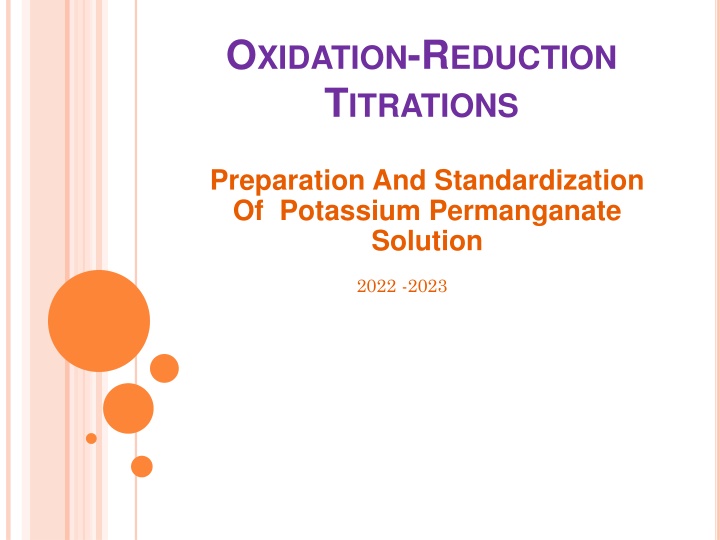
Understanding Oxidation-Reduction Titrations: Potassium Permanganate Solution Preparation & Standardization
Learn about the principles and methods of oxidation-reduction titrations, focusing on the preparation and standardization of potassium permanganate solution. Explore the importance of electron transfer reactions, assay methods, properties, and uses of potassium permanganate. Discover how oxalate compounds play a role in chemical and biological reactions, including the formation of kidney stones.
Download Presentation

Please find below an Image/Link to download the presentation.
The content on the website is provided AS IS for your information and personal use only. It may not be sold, licensed, or shared on other websites without obtaining consent from the author. If you encounter any issues during the download, it is possible that the publisher has removed the file from their server.
You are allowed to download the files provided on this website for personal or commercial use, subject to the condition that they are used lawfully. All files are the property of their respective owners.
The content on the website is provided AS IS for your information and personal use only. It may not be sold, licensed, or shared on other websites without obtaining consent from the author.
E N D
Presentation Transcript
OXIDATION-REDUCTION TITRATIONS Preparation And Standardization Of Potassium Permanganate Solution 2022 -2023
Reactions in which electrons are transferred from one species to another are called oxidation-reduction (redox) reactions. When one species loses electrons by an oxidation process another species simultaneously gains electrons by a reduction process in a chemical reaction. The balanced chemical reaction can be written as the combination of two half-reactions representing the oxidation reaction and the reduction reaction , respectively In the oxidation reduction methods of analysis, a change in valence of the reacting products is a must, while in the contrary to precipitation and neutralization methods of analysis where no change in valence occur
Assay Methods: 1- Permanganate Methods: 1.Direct Titration Methods. 2.In direct Titration Methods. 2-Dichromat Methods: Direct Titration with Potassium Dichromate. 3- Cerci Sulphate Titration Methods: Direct Titration with Cerci Sulphate
Permanganate Methods Potassium permanganate: its an inorganic chemical compound with chemical formula KMnO4,M. Wt.=158.04 It is an odorless dark purple crystalline compound, soluble in water and freely soluble in boiling water. chemically, potassium permanganate is a strong oxidizing agent both in the dry state and in solution state. Potassium permanganate is not primary standard substance because it contains reduced products like manganese oxide MnO2 where the concentration of KMnO4 changed after preparation because it dissociated via reducing agents such as ammonia and organic substances in water ;therefore, potassium permanganate must be standardized before use it and keep it at least 2-3 days after preparation at dark place and dark bottle
Uses: Potassium permanganate solution are used for both antibacterial and antifungal action, and its primarily used today for skin produced (dermatitis) caused by bacteria and fungi. The concentration of KMnO4 is usually 1:10000, one teaspoon of solution is diluted with water to 2 liters The permanganate ion is strong oxidizing reagent in an acidic medium: 2KMnO4+3H2SO4 K2SO4 + 2MnSO4 + 3H2O + 5(O) MnO4-+ 8H++ 5e- Mn2++ 4H2O
Oxalate compounds have importance in many chemical and biological reactions. the main component of kidney stones. Excess vitamin C is converted into oxalate and excreted in the gut and urine, therefore, kidney stone patients must limit their intake of vitamin C to control the formation of calcium oxalate stones, as well as foods high in oxalate, such as spinach, beets, and beans.
Standardization of potassium permanganate with oxalic acid In this experiment, The oxalate ion, C2O42-, will react quantitatively with permanganate ion, MnO4-, in the presence of strong acid according to the following equation: 2 MnO4-(aq) + 5 C2O42-(aq) + 16 H+(aq) 2Mn2+(aq) + 10 CO2(g) + 8 H2O
+5 e 2KMnO4+ 5H2C2O4+ 3H2SO4 K2SO4+ 2 MnSO4+ k2SO4+ 8H2O + 10CO2 - 2 e
PROCEDURE 1. Using measuring cylinder transfer 5 ml 0.1N oxalic acid and 5 ml sulphuric acid , swirl the contents carefully . 2. Heat the resulting solution for 1 to 1.5 min on hot plate up to 70 C. 3. Titrate the hot solution against the potassium permanganate solution, an end point is reached when a pink color persists . 4. Calculate the normality for the potassium permanganate solution.
N1V1 (Oxalic acid) = N2 V2 ( KMnO4) M.Wt. KMnO4 = 158.04 g/ mol Eq.Wt. KMnO4= -------- g/ eq
NOTES During preparation of KMnO4 solution , the liquid allowed to stand for 2-3 days . Prepared solution must be filtrated through cleaned glass wool and not cotton wool, or with filtering crucible . Avoid heat in the preparation of KMnO4 solution because traces of grease or other possible contaminants on the glass vessels used can catalyst its decomposition. Adding H2SO4 is very important in Standardization.
PROCEDURE 0 KMnO4 10 20 30 40 50 5ml H2C2O4 5ml H2SO4 heating






















